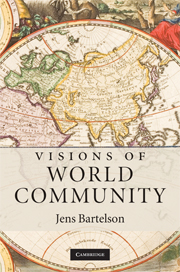3 - In the beginning was the world
Published online by Cambridge University Press: 18 January 2010
Summary
Summarizing the main trends in medieval philosophy, Maurice De Wulf once argued that medieval philosophers were driven by a ‘wish to correct the defects arising from the plurality of the states, by a unifying theory, the universal community of men’. Yet he was quick to caution the modern reader that ‘it seems superfl uous to point out that the humanitas universitas of the thirteenth century did not constitute a society of nations in the modern sense of the term’. But what kind of entity was envisaged by medieval writers? In this chapter, I shall try to provide a partial answer to this question, as well as describe how such an imagined community of all mankind was replaced by early modern notions of a world composed of different peoples. In order to account for this transition, I shall try to situate these conceptions of community in the cosmological contexts within which they were articulated. As I would like to suggest in this chapter, the medieval cosmology that had confined a united mankind to an orbis terrarium was replaced by a new worldview according to which a divided mankind was dispersed onto the dry surface of a rotunditate absoluta. In the next chapter, I shall try to show how this latter conception became crucial to subsequent attempts to explain and justify the existence of particular communities within a wider political and legal framework of nations and empires.
While some existing accounts have emphasized the importance of changing cosmological beliefs when explaining the emergence of sovereign states, none of them have bothered to systematically relate the contemporary conceptions of community to the cosmological context within which they were articulated.
- Type
- Chapter
- Information
- Visions of World Community , pp. 46 - 85Publisher: Cambridge University PressPrint publication year: 2009

